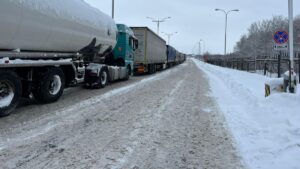
Swiss company Nestlé has launched the first production line at its new vermicelli factory in Smolyhiv (Torchynska settlement community, Lutsk district, Volyn region), which is the result of a CHF40 million ($50 million at the current exchange rate) investment announced 30 months ago, according to a press release issued by the company on Monday. according to a company press release on Monday.
“The production capacity of the first line will enable the company to produce 5,000 tons of vermicelli by the end of 2025, with a planned increase in production with the opening of additional lines in the next two years,” the release said.
Nestlé notes that the Smolyhiv factory is the fourth factory opened in the company’s 30 years of operation in Ukraine.
“With the opening of the new factory, the company has created a European hub for food production in Ukraine in Volyn, combining the new factory in Smolyhiv with the one already operating in neighboring Torchyn,” the statement said.
According to the statement, the company is expanding its vermicelli production to meet growing demand in both Europe and Ukraine under the Maggi and Mivina brands. The new factory is an export-oriented enterprise: 75% of its products will be supplied to EU markets under the Maggi brand, which will increase foreign currency inflows to Ukraine. At the same time, 75% of the raw materials for production come from local suppliers in Ukraine, with wheat and sunflower oil being the key ingredients.
“The factory’s advantageous geographical location in western Ukraine creates ideal conditions for Nestlé to produce in Ukraine for both the local market and for export,” said Alessandro Zanelli, CEO of Nestlé in Ukraine and Southeast Europe, in a press release.
He added that the factory is a modern, digital, and fully automated production facility.
Ivan Rudnytskyi, head of the Volyn Regional State Administration, recalled that a factory producing ketchups and sauces under the Torchyn brand and a Nestlé distribution center are already operating in the region, and the launch of the new factory has created more than 300 new jobs, and that this number will increase in the near future to more than 1,500 people in the newly created production hub in Volyn.
Nestlé is one of the world’s largest food and beverage companies, operating in 187 countries. It offers a wide range of products and services for families and pets.
It has over 2,000 brands. Nestlé began operations in Ukraine in 1994 with the opening of a representative office, acquired a controlling stake in ZAT Lvivska Kondyterska Fabryka Svitloch in 1998, and has owned 100% of the company since 2018.
In May 2003, Nestlé Ukraine LLC was established in Kyiv, and at the end of that year, Nestlé became the owner of 100% of the shares of Volynholding.
In 2010, Nestlé SA acquired Technocom LLC in Kharkiv, a manufacturer of instant products under the Mivina brand. In 2012, Nestlé Business Service (NBS Europe) was established in Lviv, which is one of seven Nestlé service centers in the world and provides support services to Nestlé divisions in more than 40 countries.
Nestlé’s business in Ukraine includes the following areas: coffee and beverages, confectionery, culinary products (cold sauces, seasonings, soups, instant products), baby and special nutrition, ready-to-eat breakfasts, and pet food.
At the end of last year, Dzanelli reported that Nestlé in Ukraine had increased production by 7-8% in 2024 and expects 10% growth in 2025.

According to OpenDataBot and official statistics, the German automotive company Kromberg & Schubert became the largest employer in Volyn.
The company employs over 5,000 people in Ukraine. It manufactures cable networks for cars. Previously, the WOG network was the largest employer in the Volyn region.

The trade flow of agricultural products through road and railway checkpoints in Volyn increased 19 times in 2022, and the number of food products (1-24 groups of UKTZED) cleared by customs posts in the “export” mode increased 10 times, the press service of the Volyn Customs reported.
“Volyn Customs coped with a significant increase in workload due to promptly taken measures to optimize the time of customs procedures, redistribution of personnel, joint projects with border guards and the Polish side of the pilot projects of vehicle passage,” the report quotes the head of Volyn Customs Yuriy Ivaskiv as saying at a field meeting of the Verkhovna Rada Committee on Agrarian and Land Policy.
Commenting on the work of Polish veterinary services on the Ukrainian-Polish border, Ivaskiv said that the Ukrainian side had repeatedly raised this issue at international meetings. However, the Polish side has stated that it is impossible to speed up these types of state control due to contradictions with the legislation of the European Union.
“Certain types of control (in particular, veterinary control – IF-U) can only be carried out at the border,” Ivaskiv reminded.
He noted that in August of this year, on average, 625 trucks were accepted at the Dorohusk checkpoint from Yahodyn per day, of which only 43 were carrying food products. Given the fact that all grain goods, including technical grain, are sent by the customs authorities for veterinary control, and product samples are examined within 2-3 days, trucks with this category of goods are waiting to cross Yahodyn in a separate electronic queue, he explained.
Ivaskiv reminded Volyn agricultural producers of the new requirements of the Customs Code, which will come into force on November 7, 2023. He recommended that everyone should not hesitate to apply for customs simplification in the NCTS or the status of an authorized economic operator (AEO).
“This will allow agricultural businesses to export products to the European market without having to present the goods to customs,” summarized the head of the Volyn Customs.

Because of the snowfall that began on Thursday, the movement of transport to the state border checkpoints in several regions has slowed down, the press service of the State Border Guard Service of Ukraine reported.
“The longest queues were formed on the border with Poland at the entrance to the checkpoints “Shehyni”, “Krakivets”, “Rava-Russkaya” in Lviv region, as well as before the checkpoints “Yagodin” and “Ustilug” in Volyn,” – said in the message.
It specifies that at the same time checkpoints in Transcarpathian and Chernivtsi regions are not overloaded.
“Take this information into account when crossing (the border – IF-U). In the meantime, border guards together with employees of the National Police, if necessary, carry out reverse traffic to pass cars and try to clear passengers and vehicles as quickly as possible”, – summarized in the State Border Guard Service.

The epidemic situation in Volyn, Zhytomyr, Ivano-Frankivsk, Lviv, Odesa, Rivne, Sumy, Kharkiv and Chernivtsi regions does not meet the criteria for easing lockdown, the Health Ministry said on its website on Tuesday.
The occupancy of beds, in particular, exceeds the permissible indicator of 53.31% in Lviv region. However, in Odesa and Sumy regions, the dynamics of the spread of the disease exceeds the established value of 10%.
The percentage of disease detection is higher than the established value of 11% in Volyn, Zhytomyr, Ivano-Frankivsk, Rivne, Kharkiv and Chernivtsi regions.
As reported, the Cabinet of Ministers of Ukraine introduced adaptive lockdown until August 31, 2020, changed the principle of the distribution of regions to strengthen lockdown measures.
Depending on the epidemic situation in the region or individual administrative territorial units-districts, a “green,” “yellow,” “orange” or “red” level of epidemic danger of the spread of coronavirus (COVID-19) disease is established.
CHERNIVTSI, EPIDEMIC SITUATION, IVANO-FRANKIVSK, KHARKIV, LVIV, ODESA, RIVNE, SUMY, VOLYN, ZHYTOMYR